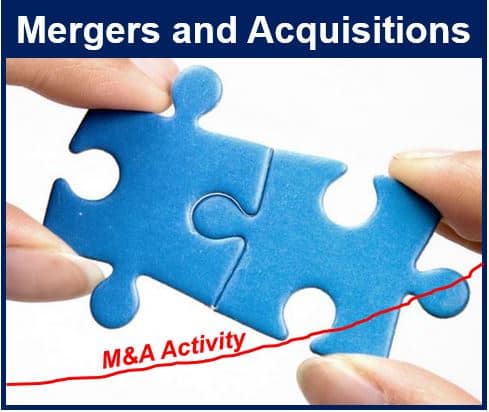Mergers and Acquisitions, often referred to as M&A, is a practice of corporate finance that deals with combining, dividing, selling, and buying different companies to create a new enterprise, merge them together, or help a company complete a takeover.
M&As allow companies in similar industries to merge and grow in their respective sector without the need to create a subsidiary or engage in a joint venture.
M&A activity has been progressively increasing over the past few decades. Experts say that today, many companies believe their only chance of surviving in this global market is by uniting with other companies. The fusion of two companies may also act as a catalyst for innovation and market expansion, as they often bring together diverse technologies and expertise from the merging entities.
Many people, when they see the acronym M&A, believe mergers and acquisitions are the same – they aren’t!

A merger is essentially the consolidation of companies to form a new company, while an acquisition is when one company buys out another company and absorbs their assets establishing itself as the new owner – as such no new company is created.Since the 1980s, M&A activity has increased considerably.
Mergers are also known as ‘a marriage of equals‘ because the companies involved are usually of a similar size and stature.
An acquisition of a company can either be ‘friendly’ or ‘hostile’, depending on the context and the means in which the acquirer goes about taking over the other company. In a friendly transaction both companies are involved in the negotiations and cooperate together. A hostile takeover occurs when the board and management of the target company is not as involved in the process and the company is bought out without them having much prior knowledge of the offer. As term implies, in a hostile takeover, the board is against the acquisition.
The whole process of an M&A can last a very long time, and there are a number of things that can go wrong in the process, such as the seller and buyer not agreeing on a selling price, sudden volatility in the market, or the possibility of the buyer backing out.
Additionally, M&A activities often lead to significant changes in company culture and organizational structure, which can pose challenges in integrating different corporate philosophies and practices.
Investment banks are currently at the forefront of providing companies with M&A advice and financing. However, there has been a recent increase in the number of specialist M&A advisers, who solely offer advice and don’t provide financing – these companies are often known as Merchant Capital Advisors.
The process of an M&A transaction is initiated with a letter of intent. The letter of intent typically binds the entities to confidentiality and exclusivity obligations so that the transaction can undergo a due diligence process – involving accountants, lawyers, and people in management from both sides.
Once the due diligence process is over then the entities draw up a “merger agreement”, “asset purchase agreement”, or “share purchase agreement”. These definitive agreements typically focus on five key terms: conditions, representations and warranties, covenants, termination rights, and provisions related to acquiring shareholders approval.
Financing an M&A deal
There are several different methods of financing an M&A deal:
Cash on hand: this is not associated with high transaction costs and consumes excess cash or unused debt capacity – potentially decreasing debt rating.
Issue of debt: consumes excess cash or unused debt capacity but typically decreases debt rating and is associated with an increased cost of debt. The transaction costs of underwriting or closing are between 1 to 3 percent of the face value.
Issue of stock: this is associated with an increase in financial slack, however, issue of stock tends to improve the debt rating and decreases the cost of debt. There are transaction costs associated with the fees for preparation of a proxy statement and registration.
Notable M&As worldwide
Here are the top ten Mergers and Acquisitions since the turn of the century. It is interesting to note that they all took place in the United States and Europe (none in Japan, South Korea, China, or Taiwan).
- AOL and Time Warner (2000) – Merger – $182.0 billion (United States)
- Gaz de France and Suez S.A. (2007) – Merger – $107.0 billion (France)
- RFS Holdings and ABN Amro (2007) – Acquisition – $98.0 billion (Netherlands)
- Royal Dutch Petroleum and Shell Transport & Trading Company plc (2004) – Merger – $95.0 billion (United Kingdom/Netherlands)
- Glaxo Wellcome and SmithKline Beecham (2000) – Merger – $76.0 billion (United Kingdom)
- Comcast and AT&T Broadband (2001) – Acquisition – $72.0 billion (United States)
- Banca Intesa and Sanpaolo IMI (2006) – Merger – $71.0 billion (Italy)
- Pfizer and Wyeth (2009) – Acquisition – $68.0 billion (United States)
- United States Department of the Treasury and American International Group (2008) – Acquisition – $67.8 billion (United States)
- AT&T and BellSouth (2006) – Merger – $67.0 billion (United States)
Video – What is M&A?
This video, from our sister channel on YouTube – Marketing Business Network, explains what the term ‘Mergers & Acquisitions or M&A’ means, using simple and easy-to-understand language and examples.
